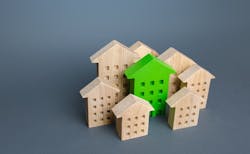Net Zero Construction Is on the Rise, but Inconsistent Regulations Could Halt Progress
Slowly but surely, home builders are trading out traditional construction techniques with net-zero building practices, but an array of ever-changing regulations are causing confusion and holding up progress. The U.S. lags behind other nations in terms of net-zero guidelines and legislations, and while the EU has codified some net-zero requirements into law, state governments are in control across the pond, leaving room for inconsistencies and uncertainty on what exactly constitutes net-zero state by state.
As a result, builders in the U.S. are left in the dark about the most efficient path toward sustainable building, but a solid first step is to baseline and benchmark carbon emissions in existing homes or new projects to determine a framework for success for each individual project, Forbes reports.
Following baselining and benchmarking, a framework for success can be built, retrofitting and capital improvements can be identified, and the reduction of energy supply and renewables can begin.
Technology is a critical tool in any building owner’s net-zero mission. The rapid evolution of smart building technology in the last decade has been groundbreaking, connecting systems to enhance productivity, building efficiency, workplaces and people. But how is smart building technology facilitating a net-zero action plan?
